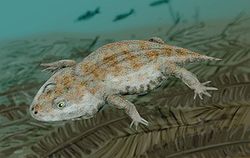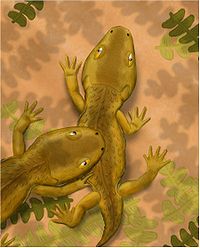- Amphibamidae
-
Amphibamidae
Temporal range: Early Permian–Early Triassic, 284–248 Ma
Amphibamus grandiceps Scientific classification Kingdom: Animalia Phylum: Chordata Class: Amphibia Order: Temnospondyli (unranked): Euskelia Superfamily: Dissorophoidea Family: Amphibamidae
Moodie, 1916Genera - Amphibamus (type)
- Doleserpeton
- Eoscopus
- Georgenthalia
- Gerobatrachus
- Limnerpeton
- Micropholis
- Pasawioops
- Platyrhinops
- Plemmyradytes
- Tersomius
Synonyms - Doleserpetontidae Bolt, 1969
Amphibamidae is an extinct family of dissorophoid euskelian temnospondyls. The earliest amphibamids such as Amphibamus are known from Early Permian strata in the United States, while the last known amphibamid, Micropholis, is known from the Early Triassic Karoo Basin of South Africa. According to some phylogenetic studies, modern amphibians, including frogs and salamanders, may have descended from a common ancestor that was an amphibamid.
Contents
Classification
Cladogram from Schoch and Rubidge (2005):[1]
Amphibamidae Eoscopus
Platyrhinops
Cladogram from Huttenlocker et al. (2007):[2]
Amphibamidae Platyrhinops
Eoscopus
"Tersomius" mosesi
"Tersomius" sp.
Plemmyradytes
Cladogram from Fröbisch and Reisz (2008):[3]
Amphibamidae Georgenthalia
Eoscopus
Plemmyradytes
Platyrhinops
Tersomius
Pasawioops
Relationship to Batrachia
Amphibamidae contains the genus Gerobatrachus, which has been interpreted as the sister taxon of Batrachia, the modern amphibians.[4] This would make Amphibamidae a paraphyletic taxon, since it would not contain all descendants of the last common ancestor of amphibamids. If Gerobatrachus is the sister taxon of Batrachia, then all modern amphibians descend from an amphibamid ancestor. Below is a modified cladogram from Anderson et al. (2008) showing Batrachia nested in Amphibamidae, with Gerobatrachus as the sister taxon of Batrachia:[4]
Amphibamidae Tersomius
Eoscopus
Platyrhinops
Gerobatrachus
Batrachia Anura
Caudata
Albanerpetontidae
The cladistic analysis of Anderson et al. (2008) supported the "polyphyly hypothesis" of modern amphibian ancestry, whereby some extant amphibian groups are descendants of temnospondyls while others are descendants of lepospondyls, another large group of Paleozoic amphibians.[5] Caecilians were nested within Lepospondyli, making Lissamphibia polyphyletic. However, the placement of Batrachia within Amphibamidae has been controversial, and alternate hypotheses of lissamphibian ancestry remain. Some authors of more recent studies have suggested that the findings of Anderson et al. (2008) may be wrong, and that lissamphibians are descendants of lepospondyls.[5] This would make Amphibamidae a monophyletic grouping much more distantly related to lissamphibians.
References
- ^ Schoch, R.R.; and Rubidge, B.S. (2005). "The amphibamid Micropholis from the Lystrosaurus Assemblage Zone of South Africa". Journal of Vertebrate Paleontology 25 (3): 502–522. doi:10.1671/0272-4634(2005)025[0502:TAMFTL]2.0.CO;2.
- ^ Huttenlocker, A.K.; Pardo, J.D.; and Small, B.J. (2007). "Plemmyradytes shintoni, gen. et. sp. nov., an Early Permian Amphibamid (Temnospondyli:Dissorophoidea) from the Eskridge Formation, Nebraska". Journal of Vertebrate Paleontology 27 (2): 316–328. doi:10.1671/0272-4634(2007)27[316:PSGESN]2.0.CO;2.
- ^ Fröbisch, N.B.; and Reisz, R.R. (2008). "A new Lower Permian amphibamid (Dissorophoidea, Temnospondyli) from the fissure fill deposits near Richards Spur, Oklahoma". Journal of Vertebrate Paleontology 28 (4): 1015–1030. doi:10.1671/0272-4634-28.4.1015.
- ^ a b Anderson, J.S.; Reisz, R.R.; Scott, D.; Fröbisch, N.B.; and Sumida, S.S. (2008). "A stem batrachian from the Early Permian of Texas and the origin of frogs and salamanders". Nature 453 (7194): 515–518. doi:10.1038/nature06865. PMID 18497824. http://www.cnah.org/pdf_files/988.pdf.
- ^ a b Marjanović, D.; and Laurin, M. (2009). "A closer look at published data matrices reveals support for the "lepospondyl hypothesis" on the origin of Lissamphibia". Abstracts from the 7th Annual Meeting of the European Association of Vertebrate Palaeontologists: 45. http://www.eavp.org/abstracts/2009_eavp_abstracts.pdf#page=47.
External links
Major clades Related articlesRelated categoriesTemnospondyls · Carboniferous amphibians · Permian amphibians · Triassic amphibiansDissorophoidea AmphibamidaeAmphibamus · Doleserpeton · Eoscopus · Georgenthalia · Gerobatrachus · Limnerpeton · Micropholis · Pasawioops · Platyrhinops · Plemmyradytes · Rubeostratilia · TersomiusBranchiosauridaeApateon · BranchiosaurusBranchierpeton · Limnogyrinus · MicromelerpetonAlegeinosaurus · Anakamacops · Arkanserpeton · Aspidosaurus · Astreptorhachis · Brevidorsum · Broiliellus · Cacops · Conjunctio · Dissorophus · ?Ecolsonia · Fayella · Iratusaurus · Kamacops · Longiscitula · Mordex · Platyhystrix · ZygosaurusTrematopidaeAcheloma · Actiobates · Anconastes · ?Ecolsonia · Fedexia · Phonerpeton · TambachiaEryopoidea ParioxyidaeParioxysCategories:- Temnospondyls
- Prehistoric amphibians of Africa
- Prehistoric amphibians of Europe
- Prehistoric amphibians of North America
- Permian amphibians
- Triassic amphibians
Wikimedia Foundation. 2010.


